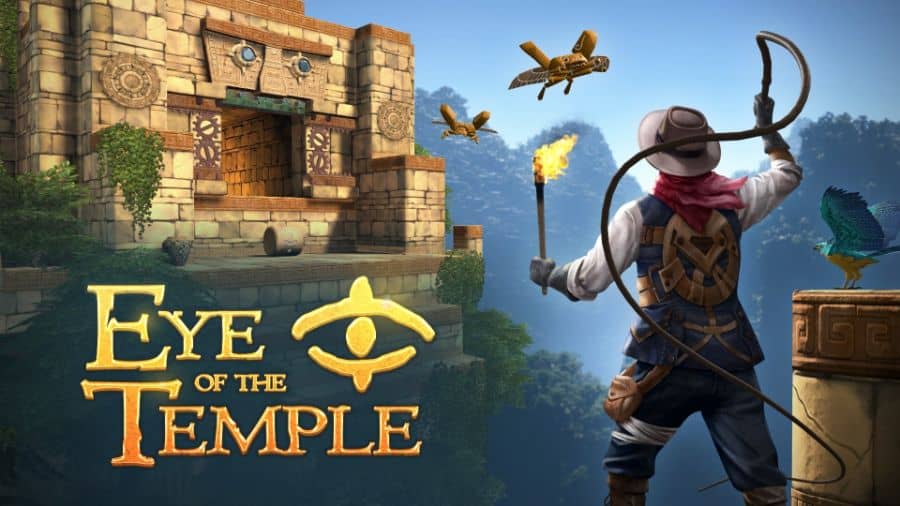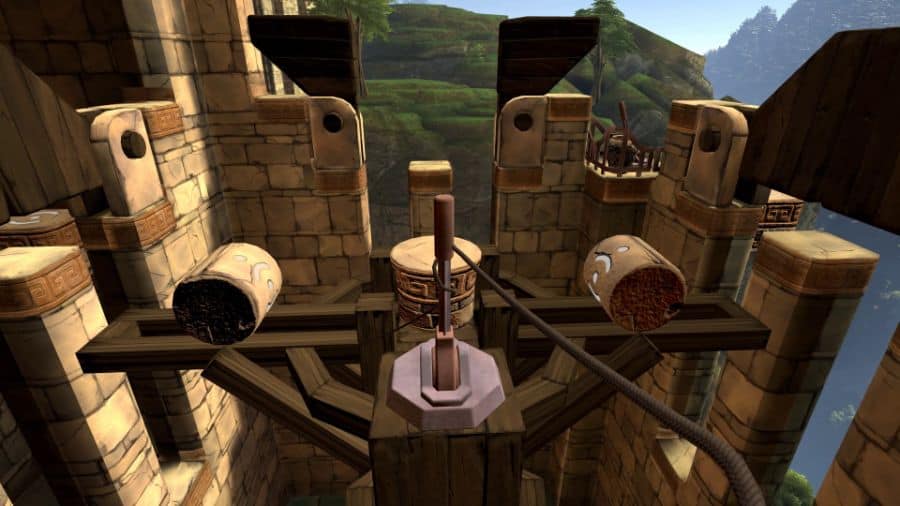
Prepare to embark on an exciting journey as I explore this enjoyable and immersive room-scale VR adventure. Developed by Rune Skovbo Johansen and Salmi Games, Eye Of The Temple transports you into an Indiana Jones-like universe, filled with intricate puzzles and engaging gameplay. This Eye of the Temple review will cover everything you need to know about the game and help you decide if it it’s worth playing.
Eye of the Temple seamlessly blends platforming, exploration, and clever game mechanics to create an immersive VR experience. With a hint of nostalgia and a dash of innovation, this game strikes a beautiful balance between its adventurous spirit and cutting-edge technology. Let’s dive in as I uncover the secrets of this enigmatic temple and discover if Eye Of The Temple deserves a spot in your gaming library.
Eye Of The Temple Overview
Set in a mysterious temple, players are tasked with solving puzzles and overcoming obstacles in order to defeat the game’s antagonist, ‘The Darkness’. Equipped with a whip and a torch, players navigate a grid-based map, hopping between moving blocks and mastering various gameplay mechanics.
Originally released for PC VR in October 2021, Eye of the Temple made its way to the Quest 2 and Quest Pro on April 27, 2023. The game is priced at $19.99 and requires a play space of 2m wide by 2m long to fully experience its innovative room-scale platforming design.
Room-Scale Platforming: The Unique Movement Mechanics
Eye of the Temple sets itself apart from other VR titles with its innovative room-scale platforming mechanics, which make a substantial impact on the gaming experience. By expertly utilizing your play space, the game creates an unparalleled sense of immersion and keeps players fully engaged.
My home play space measures approximately 3m by 3m, and I was initially uncertain about how well the game would work in this space. However, Eye of the Temple’s ingenious design quickly dispelled my doubts.
The game cleverly manipulates your play space, allowing you to move throughout the entire game world while consistently keeping you away from the boundaries. This approach generates the sensation of genuinely traversing the temple, which completely blew my mind, and goes a long way toward making VR feel more realistic.
As I continued to play, the game’s smart design made me forget about my physical constraints, allowing me to lose myself in the temple’s rich atmosphere and captivating puzzles. The map’s layout, combined with the strategic use of roller blocks, contributes to the seamless movement experience, encouraging players to navigate the environment without ever feeling restricted.
Not only does Eye of the Temple showcase VR game design at its finest, but it also serves as a prime example of how developers can push the boundaries of room-scale platforming. The unique movement mechanics employed in this game demonstrate the creativity and skill of the developers, proving that it’s possible to create an immersive and engaging VR experience within a limited space.
To learn more about the challenges of VR design and how to optimize performance, check out our article on why VR is so demanding.
Campaign And Gameplay: Mixing It Up With Puzzles And Combat
Eye of the Temple’s campaign offers a balanced mix of puzzles and combat, ensuring that players remain engaged and entertained throughout their adventure. The game’s core mechanics, which revolve around room-scale platforming, are further enhanced by the addition of various items, obstacles, and challenges that keep the gameplay fresh and exciting.
One of the most notable aspects of the gameplay is the use of two essential tools: the whip and the torch. These items not only add complexity to the puzzles and platforming sections but also serve as integral components in the game’s combat system.
Players will find themselves utilizing the whip to smash items, pull levers, and engage in combat with pesky scarab enemies. The torch, on the other hand, is essential for lighting dark passages, and beacons, and triggering various effects throughout the game.
While the campaign is well-paced and offers an engaging mix of challenges, it’s worth noting that the combat system may feel a bit basic for some players. The whip unfurls automatically only on relevant blocks, which means that it’s not always available when you might want to use it. Nevertheless, the whip is a joy to use, and its depth ensures that players will see their technique improve as they progress through the game.
Eye of the Temple does a great job of building on its room-scale platforming concept, introducing increasingly difficult scenarios and elements as the campaign unfolds. The puzzles strike an excellent balance between being challenging enough to require thoughtful planning and never becoming overly frustrating or tedious.
The game’s visual design also aids in the intuitive understanding of each environment, allowing players to progress without needing excessive hand-holding or explicit instructions.
The campaign’s structure starts to open up later in the game, offering a more non-linear experience that allows players to choose the order in which they tackle certain areas. This flexibility provides a sense of freedom and control, and for those who prefer an extra challenge, there is even the option to skip some sections and head straight to the final boss.
Graphics And Performance

Eye of the Temple delivers an impressive visual experience on both the Quest 2 and Quest Pro platforms, showcasing the game’s adventurous style and offering an immersive journey through the temple. The graphics, while not without a few compromises, are still impressive compared to other Quest 2 games, ensuring that players can fully appreciate the game’s captivating environments.
The game’s performance on the Quest 2 and Quest Pro is smooth and hitch-free, a testament to the developers’ efforts in optimizing Eye of the Temple for standalone VR platforms. Despite the technical challenges faced in bringing the game to the Quest 2, players can expect a seamless and enjoyable experience throughout their adventure.
That being said, there are a few visual compromises worth noting. One of the most apparent is the implementation of fixed-foveated rendering, which results in a noticeable horizontal line where the resolution switches to a lower quality near the periphery of the player’s field of view. While this is mostly unnoticeable during gameplay, more discerning players might find it slightly distracting.
Additionally, some textures have been downgraded in resolution to accommodate the performance requirements of standalone headsets. Although these changes are rarely drastic and do not detract from the overall visual experience, players who pay close attention to detail might pick up on these adjustments.
Despite these minor compromises, Eye of the Temple manages to achieve a breathtaking sense of scale in its environments, which is particularly impressive for a standalone VR title. The game also excels in other visual aspects, such as water effects and rope physics, further enhancing the immersive experience.
Comfort and Accessibility: A Game Tailored For An Enjoyable VR Experience
One of the standout features of Eye of the Temple is its focus on comfort and accessibility, ensuring that players can fully immerse themselves in the game without worrying about the usual VR-related hassles. The game’s unique room-scale platforming design creates a sense of continuous movement while effectively managing the player’s guardian space, resulting in a comfortable and enjoyable experience.
The game requires a minimum 2m by 2m play space, which, although larger than some other VR experiences, is utilized ingeniously by the developers to maintain player comfort. If you’re wondering how much space you need for other VR experiences, read our guide on space requirements for VR.
The clever design tricks employed in Eye of the Temple ensure that players are never put in a position where they walk into walls or need to step outside their guardian boundaries.
The lack of artificial movement in the game further contributes to its accessibility, making it an excellent option for VR newcomers or those who may be sensitive to motion sickness. By focusing on real, physical movement, Eye of the Temple provides a natural and intuitive VR experience that remains comfortable throughout the entire campaign. For those who wear glasses and are concerned about using VR, check out our article on whether you need glasses for VR.
Replayability And Speedrunning
Eye of the Temple understands the importance of offering players a reason to return to its captivating world, which is why it features a dedicated speedrunning mode alongside its main campaign. With this mode, players can put their skills to the test as they race against the clock to complete specific areas or even the entire game, all while vying for the top spots on the leaderboards.
The speedrunning mode currently covers three separate areas of the map, providing a variety of challenges that cater to different skill levels. As an added bonus, the developers have plans to introduce more individual areas in future updates, ensuring that the thrill of competition remains fresh and exciting.
In addition to speedrunning, the non-linear structure of Eye of the Temple’s main campaign encourages replayability by allowing players to approach the game in different ways each time. You can choose to skip certain areas for an extra challenge or focus on mastering specific sections to improve your skills.
With its diverse gameplay options and a strong emphasis on replayability, Eye of the Temple guarantees a thrilling and rewarding experience that will keep you coming back for more adventures in its mesmerizing world.
Bottom Line
Eye of the Temple is a remarkable VR experience that masterfully blends room-scale platforming, engaging puzzles, and thrilling exploration within an immersive Indiana Jones-inspired setting. The game’s innovative design, captivating environments, and diverse gameplay options create a memorable adventure that both newcomers and seasoned VR enthusiasts can enjoy.
With its speedrunning mode and campaign structure, Eye of the Temple offers plenty of replayability, ensuring that players will be eager to spend plenty of hours playing. This game stands as a shining example of what can be achieved with intelligent VR design, and it is undoubtedly a must-have addition to any gaming library. For more must-play VR games, take a look at our list of 20 best VR RPGs.
